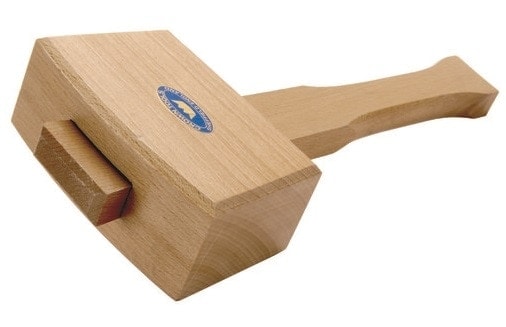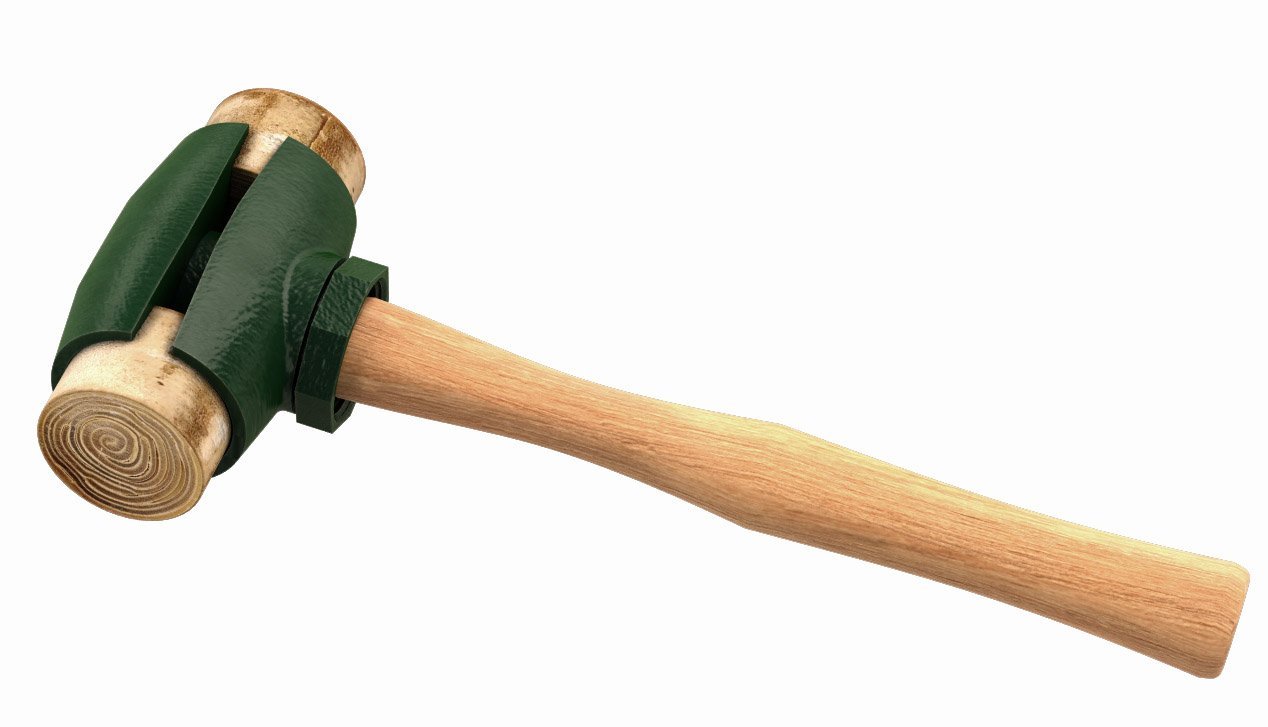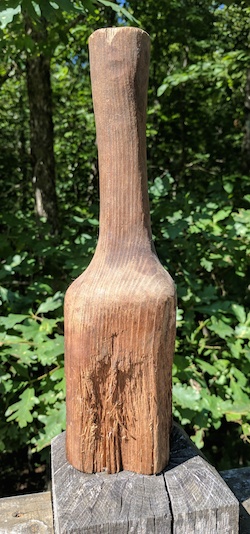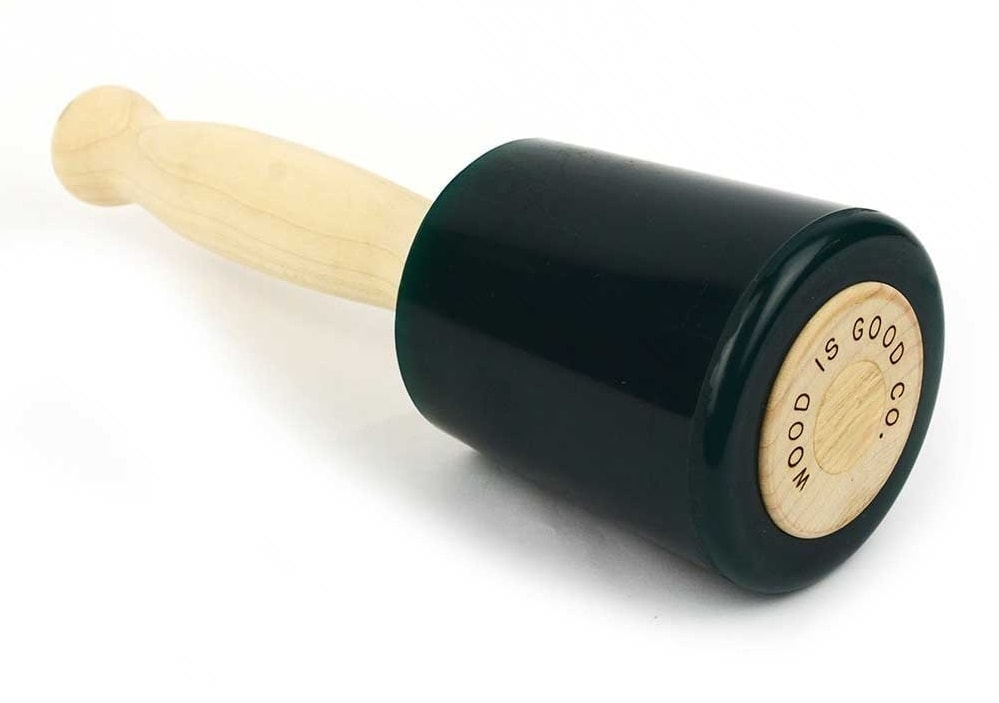As beautifully crafted as some mallets are, at the end of the day, they’re a blunt instrument. Although designed to hit chisels and other tools, mallets are not without their own set of attributes. The best mallet for timber framing is the one that transfer the longest and most potent impact to a tool. The basic physics accomplished from this transfer of energy results in a chisel pushing through wood. To efficiently complete that task, it’s important that your mallet has low rebound qualities. If it glances or bounces off the chisel, it’s ineffective. For timber framing, something in the 30-ounce range makes sense. That heft carries enough weight to push the chisel but won’t exhaust your arm too quickly. Heads can be made of a variety of materials, but hardwoods and some plastic products seem to deliver the best blow.

| 
| ||
|---|---|---|---|
Crown | Garland | ||
Weight | 30 oz | 20 oz | 64 oz |
Head Material | Urethane | Beech | Customizable |
Country of Origin | China | England | USA |
This Wood is Good mallet enjoys a 3 ½-inch urethane rounded head and its polished handle is turned from strong hardwood. The 30-ounce pounder will transfer a substantial impact to your chisel or gouging tool. Being a relatively hefty mallet, it manages work with 2 inch chisels well. Its head absorbs a lot of the vibrations and that allows for more continuous work without hand fatigue.
I made several hand made mallets before finding this one, it will also be the last one I need to buy. Other owners heap nothing but praise on this Wood is Good. It demonstrates excellent balance, ergonomics, durability and is easy on chisel heads. Timber framing professionals can’t miss by adding this to their tool boxes.
Crown 4-1/2-inch Beechwood Mallet
Crown Hand Tools hail from Sheffield, England, and this 20-ounce woodcarving mallet is crafted from kiln-dried beech. It features all-wood construction and a flat head that squares impact directly into your chisel. Weighing 10 ounces less than the Wood is Good mallet, this tool may be more geared toward carving and refined work than deep gouging. However, it tends to soak up linseed oil and gains weight after a few treatments.
Mallet owners give Crown relatively high praise for its craftsmanship and balance. Some of the negatives point to the tool being a little rough to the hand and needing some sanding.
If you’re looking for a rugged timber framing mallet, this may not be ideal. It does make a nice bench tapper though.
Garland Mfg 31004 Split Head Hammer
Garland’s split-head hammer blends the idea of a hardwood mallet with mini-sledge power. At a meaty 4 pounds, this dead blow features two interchangeable head faces attached by a metal wedge. Another Made in USA product, this hammer has 6 different types of heads that include soft rawhide, nylon, urethane, plastic, copper and BASA. It’s a powerful hand tool whose BASA heads are renowned for firebrick installation and demolition. Dead blows tend to provide excellent impact transfer and this big boy accomplishes that easily. This Garland also gives you the ability to strategically change heads to meet specific tasks.
Users give the split-head high marks for its tremendous versatility and rugged craftsmanship.
The Maine-based toolmaker has created a proud legacy over the last 150 years and continues to be a mallet and hammer leader. This split-hammer can handle diverse work for craftsman in various commercial areas.
Hand Made Mallets

If you’re a professional woodworker, picking up the Wood is Good mallet is worth the time, trouble and money. For multiple uses, Garland is like having Harry Potter’s magic wand. But if you want to experience the do-it-yourself joys of tool-making, a mallet isn’t all that difficult.
Just about any block of hardwood can be fashioned into a mallet head. You can use a lathe to make it into a perfect cylinder, leave it as rough piece of limb or use a square block. Knots and grain pattern don’t matter all that much. Cut a hole all the way through. You can go round with a drill or, ironically, make a square mortise using a chisel and mallet. The cut should have a slight taper. If you have a 1-inch handle, cut the mortise to broaden to 1 ¼ inches on one side. This will provide space to press a wedge where the handle and head meet after pounding it through.
Once it’s assembled, apply several coats of linseed oil. This will help preserve the wood and add heft to your tapper. As the mallet wood expands, it should tighten around your handle organically.
Hand-made mallets can be effective and good ones can earn you mild envy from novice woodworkers and friends.
Timber Frame HQ is a participant in the Amazon Services LLC Associates Program, an affiliate advertising program designed to provide a means for us to earn advertising fees by advertising and linking to amazon.com. When you purchase something from Amazon, a small percentage of the sale goes to support the efforts of TFHQ.

Hi Bryce, have you tried using a dead blow mallet? I’ve used one I got from Lee Valley for a couple of years – it’s a 32 oz mallet, with a lead shot filled head – works really well with framing chisels – has virtually zero rebound, and excellent shock absorbtion.
I do have one and have used it for timber framing. I stopped using quicky after I started because I was tearing up the head of it. Certainly a great mallet to use and cheap to pick one up at the local hardware store. What type of chisel are you using?
Thorhammer.com
I like their hardwood mallet. It’s like a plywood head. They also have comparable mallets to garland.
Thanks, Will. Will have to check them out.
Heavy timber framing with a. ‘Wood is Good” 30 Oz is hard work. I’m using one now on a job in which I’ve worn through two hardwood mallets. The thing is too light and the urethane shock absorbtion reduces the force applied to the framing chisel head. Sure it will last a long while, but once I replace the hardwood mallets it’ll be given away.
Thanks for weighing in Steve, I agree that you lose some of the force with the urethane but I will gladly give it up for not having the impact of the hardwood mallet. What Hardwood Mallet do prefer? If you plan on giving it away, I would love to see you donate it to the TF Guild for their projects. I will be more than happy to pay for shipping.
I do a lot of heavy timber assembly, but not a ton of fabrication. I am getting more into crafting my own and have been using my chisels a lot more lately. I just picked up a new Robert Sorby 1 1/2″ framing chisel and I LOVE it. Looking for a new mallet to pair it up with but don’t think the Wood Is Good would be a good fit for me… Looking for advise…
The Wood is Good is labeled on the Amazon page as made in CHINA….not USA as claimed above.
That’s odd- the 18 and 20 oz are still labeled on Amazon as made in USA
you can also buy them from Highland Woodworking https://www.highlandwoodworking.com. That might not change where they are made, but it avoids Amazon and supports a specialty house.
Thanks for pointing that out, you can find them at https://www.highlandwoodworking.com/wood-is-good-carving-mallet.aspx